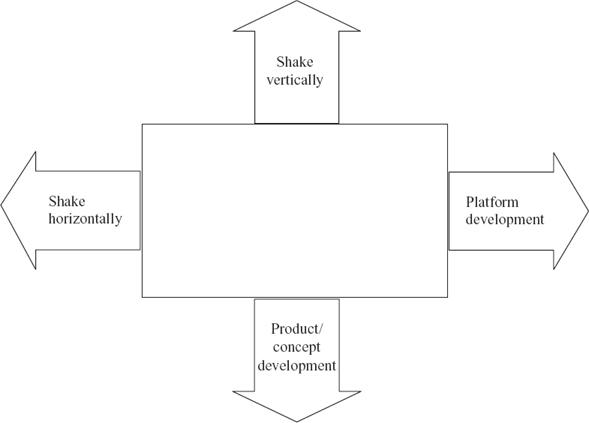21
Preparations for the final step
Shaking the box is just a simple way of breaking your routines. Because that's what the creative process is all about: following a rule or routine with an uncertain outcome. But when you are trying to shake the box, you need to make sure that it's got enough room inside it. And the outcome will, of course, depend on what is inside it.
This part of the book is about bringing together the insights and research results described in Parts I and II. In Part I, we practised expanding the box to free our minds from rules and conventions, common sense, and the limitations of our physiology and consciousness. We tested how easy it can be to think innovatively and find novel ideas if you can break free of self-imposed limitations. In Part II, we filled your now expanded box with some insights into how people perceive products and brands, and how you create meaning.
When we combine the exercises from Part I with the insights from Part II, we can easily see that there are many ways in which we can shake the contents of our expanded box. You ‘shake the box’ when you combine all the knowledge you have with the insights you've acquired into how people function in order to create new business possibilities. But to get the result from shaking the box, you need patience and some solid preparation. Let us therefore now go through what you need to achieve a really creative result before we attack the exercises.
What is involved in shaking your particular box will depend on the box having enough room for all the puzzle pieces you added to move around freely and result in the maximum number of new and remote combinations. For this reason, it's important to keep returning to your expanded box in your mind's eye and bringing back with you the basic insights gained from expanding it in the first instance. By identifying the rules and conventions that limit the business you are in for example, you can identify appropriate points of departure for shaking the box. By putting your creative result into the context of the prevailing rules and conventions of your area of business, you can identify the meaning for the consumer in your innovation, and also the threats and opportunities in implementing it. Similarly, you can discover new characteristics and unique advantages to make consumers aware of by constantly reminding yourself to open your mind. And by reminding yourself that common sense has a limiting effect, you can challenge yourself and your colleagues to keep shaking the box and not become fixated too soon on solutions that seem to be the ‘right’ ones. So it is generally a good idea to alternate work on shaking the box with going back to do the exercises designed to expand the box.
Shaking the box is in fact just a simple means of breaking your routines. Because that's what the creative process is all about: following a rule or routine with an uncertain outcome. The outcome will depend primarily on what kinds of puzzle pieces you have in your box. The more of your knowledge you can utilize, the more possible combinations there will be. The difference between a fun exercise and creating new business propositions lies in the preparation. It can be stimulating and eye-opening spontaneously to throw in aspects of your business and associations stemming from it and test what happens when you shake the box, just as with the exercises for expanding the box. But if you want this shaking of the box to unleash your potential as a creative business innovator, and the result to be taken seriously, you need to do some solid preparation. It's worth repeating that creativity is not about disconnecting yourself from knowledge but rather very much the opposite: it's about utilizing the knowledge that you have. Shaking the box is only a very small part of what it takes to prepare yourself.
It's just as important to prepare yourself as it is to work with the combinations that you shake out from the box. Your creative result needs to be meaningful and novel, and it's for this very reason that the interpretation of the combinations you shake out from your box is absolutely decisive in the process. We concluded earlier that the novelty value does not need to be particularly great and that the actual change in the product or business can very well be quite minor. The main thing is that it is also meaningful – that it means something to the consumer. It follows from this that the more insights into human behaviour, economics and business that you are able to put into the process, the more powerful bisociations you will make and the more meaningful the result has the power to be.
Many of the exercises that follow might appear at first sight to be rather mechanical and may even feel like exercises in accounting. But remember that the mechanics are in fact the important part, forcing you to unleash the power of your thinking in a systematic way so that your thoughts can move beyond your brain's riverbeds and thought tunnels. Without routines and a systematic approach, you simply won't see new associations or be able to make new, unforeseen connections. It's that ‘accountant’ that forces you to notice things that you previously have dismissed as unrelated or irrelevant (information and pieces of the puzzle that go against rules, conventions and common sense), making it possible to see new solutions.
Being systematic will also help you to make the creative process something to be taken seriously and assist in getting it accepted within your organization. In Parts I and II of this book, we saw how a relatively strongly regulated organization in fact provides the best foundation for business innovation and creativity. And that creative processes must be well structured in order to become part of what people do routinely in their work, and for these processes to be accepted as an important part of your business activities. Just as everyone understands how important the accountant's work is in listing and putting a value on all the constituent parts of the company and its transactions, it will be easier for you and others to understand that the creative process is important if, in a similar way, you draw attention to all the possibilities for new business presented by your company's operations and environment.
Systematically following a routine is not the same thing as just marking time. It's perhaps relatively easier to understand the purpose of the exercises for expanding the box, and when you go back to them the box inside your head gets bigger and you automatically get a new point of reference for thinking innovatively. But the process of shaking the box is not quite as clear-cut. For this reason, it's important regularly to monitor the results coming out of your routines and exercises to be able to build on what's been done previously and keep moving forward. Firstly, you will want to avoid repeating yourself unnecessarily and risk creating new riverbeds to get stuck in. Secondly, just like the accountant, you will want to record your results: to feel that you have achieved something (which we concluded above was quite important); and be able to build further on your results in the future. While the results might not seem to be immediately meaningful, new and powerful interpretations may occur to you when you see them in a new light (perhaps along with other pieces of the puzzle or additional insights into human behaviour and business). Thirdly, you should evaluate the exercises. Which ones worked best and are therefore worth continuing to use in your creative process? It's probable that they will not all suit your ways of thinking and working. To unleash the power of your knowledge and thinking, you will want to work in ways that inspire you the most. But it's worth while remembering that exercises that do not sit well with you today might work better tomorrow after you have gained some new knowledge and insights and/or are working with something completely different.
Enough of the lecturing! Hopefully by this point you will feel well equipped and highly motivated to throw yourself into ‘shaking the box’.
Two ways of shaking the box
Figure 21.1 illustrates the two principal ways you can shake the box. You can shake it up and down (vertically) to develop new products and concepts. In doing this, the aim is to free yourself from the product and the business and look for ideas that may end up being in quite different product categories and businesses than where you started from. Or you can shake the box sideways (horizontally) to develop the platform on which your existing business rests. This instead involves making your existing product or operations the point of departure, and bringing out new aspects of it that can expand your business around it.
The division into two ways of shaking the box is mainly for the purposes of learning. There is no bulkhead between these two ways of shaking the box, and one often leads into the other. New products and concepts may require different platforms than the ones you are using, or demonstrate a new direction and thus also have an impact on the platform for your current business. The development of a new platform may in turn provide the impetus and prerequisites for new products and concepts. The main reason for dividing the exercises into these two groups is to provide concrete goals for the exercises. Among the very first things that we concluded in this book is that, as humans, we need to have goals and to know why we are doing things. If you know that the goal is product and concept development, or platform development, you will be more strongly motivated to do an exercise because you will know why you are doing it. It's also easier to interpret and work with the results of the exercises and make meaningful biso-ciations if you think in terms of products, concepts or platforms separately.

The exercises that follow are intended to give you real, worked through suggestions for the creation of new business propositions. A lot of work is required both before and after the actual shaking part, which is really a very small tool for building or modifying a very big machine. But the exercises can also be used of course in the same way as the exercises for expanding the box. By simply spontaneously throwing in a variety of associations and rapidly interpreting the results, alone or in a group, you can open your eyes to how easily we can become blind to the possibilities inherent in our products and businesses and also be inspired to find new angles and combinations. If you then choose to continue working in quite different ways than those suggested by the exercises, they will still have served a very important purpose.
The next two chapters contain only a handful of exercises. You might even recognize some of them, as there are many variants of exercises on the same theme in this area in the literature. The exercises in this book are fairly basic and can be developed in many different ways based on the business in which you are applying them, and based on your goals; and they can naturally also be combined in new ways. The aim is to give you a feeling for how this process works, and a springboard from which you can be creative in both using these exercises and developing your own exercises.

